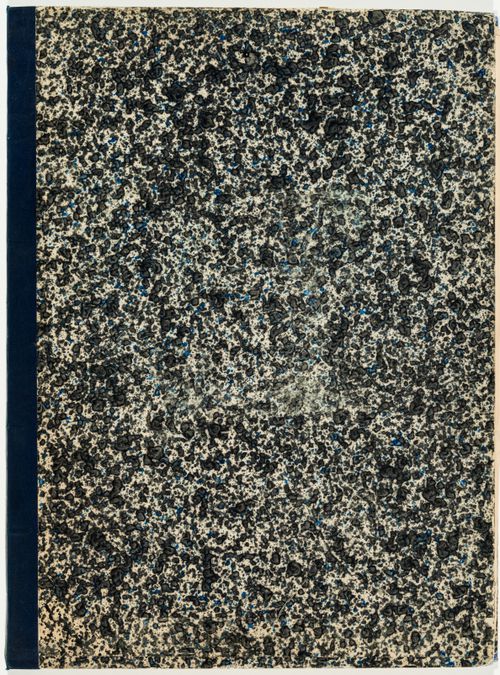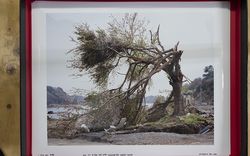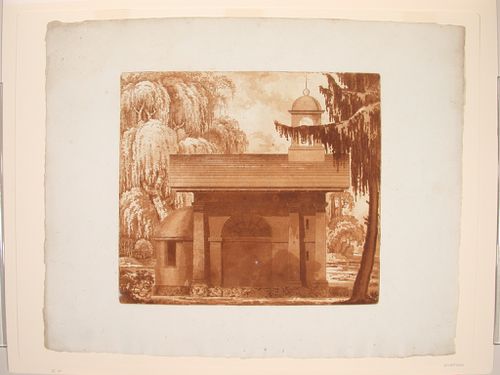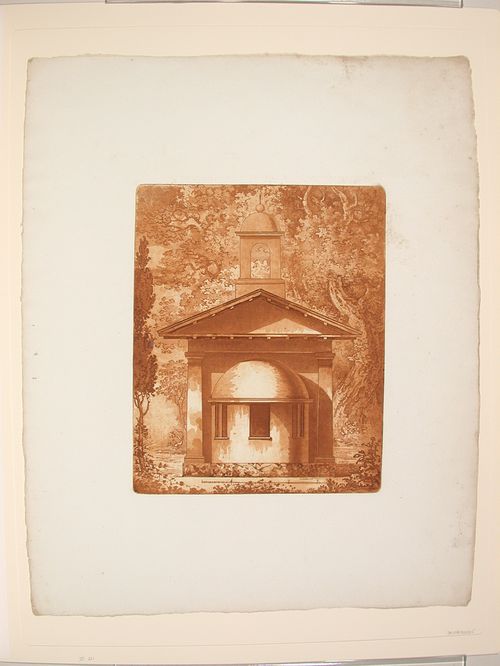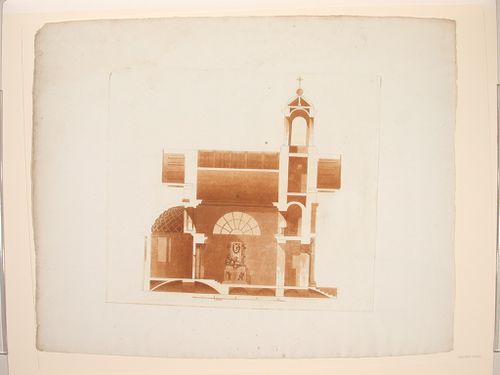Project
Generator
AP144.S2.D100
Description:
File documents Generator, an unexecuted project for the Gilman Paper Company, at the White Oak Plantation, in Yulee, Florida. After an initial investigation Cedric Price proposed a complex that could accommodate company activities, cultural events, and artist residencies and would provide "a menu of items for individual and group demands of space, control, containment and delight. A place to work, create, think, and stare." ('Architectural Review', Jan. 1980, 16). The design called for timber-framed structures with variable infill panels and cladding, along with screens, to be placed on a grid of concrete pads by cranes with the help of computers in response to users' needs. Conceptual, schematic and design development drawings show grid placement, site layout, landscaping, designs for cubes and components, proposed activities, axonometric views, and design notes with sketches. Development sketches, site plans, and charts include site analysis examining future growth, activity charts, shadow study plans, and axonometric details. Drawings of the structures include: plans, elevations, details, and perspective views for cubes, screens, and cladding; shadow studies for cube variations; and axonometric views of cube arrangements. Other drawings include: site plans and sections; landscaping and parking layouts; plans for circulation patterns; drawings for boardwalks; and electrical and drainage plans. Charts study design validity, activities, networks, project feasibility, component life-cycle, and cube and component placement/construction sequencing. Computer generated printouts by John Frazer, et al show perspective views of cubes from various viewpoints. Two sets of annotated reprographic copies show details for a typical cube and the foundation. Presentation and publication materials include: photographs and reprographic copies of design models; coloured reprographic copies of computer parts and facilities; a coloured air-brushed rendering of cubes and screens by "Jeremie '77"; two perspective renderings; and reprographic copies made from published material. Some material in this file was published in 'Building Design', 23 February 1979; 'Building Design', 9 November 1979; 'Architectural Review' (January 1980), 16-17; 'L'Architecture d'Aujourd'hui', December 1980; 'Techniques et Architecture', December 1980; 'Design', January 1981; 'New Scientist', 19 March 1981; 'Schemes: Cedric Price' (ex. cat.; London: Waddington Galleries, 1981); 'Cedric Price-Works II' (London: Architectural Press, 1984), 90, 92-97. Material in this file was produced between 1959 and 1995, but predominantly between 1976 and 1980. Main consultants for Generator in the United Kingdom include Felix J. Samuely & Partners, consulting engineers; Baker, Wilkins and Smith, quantity surveyors; John Frazer, computer modelling and systems; Sandy Brown Associates, acoustic consultants. Main consultants in the United States include Marvin Boutwell; Law Engineering Testing Company as consulting engineers; and WTCA; Robertson Ward Jr., as architects. Computer printouts in group DR1995:0280:538-552 in Generator (AP144.S2.D100) are attributed to John and Julia Frazer, Art and Design Research, Ulster Polytechnic and the Department of Architecture, Liverpool Polytechnic. Some material in group DR1995:0280:567-576 is attributed to Felix J. Samuely & Partners. File contains conceptual drawings, design, development drawings, presentation drawings, photographic materials, boxes, an artefact, models, and textual records.
1959-1995, predominant 1976-1980
Generator
Actions:
AP144.S2.D100
Description:
File documents Generator, an unexecuted project for the Gilman Paper Company, at the White Oak Plantation, in Yulee, Florida. After an initial investigation Cedric Price proposed a complex that could accommodate company activities, cultural events, and artist residencies and would provide "a menu of items for individual and group demands of space, control, containment and delight. A place to work, create, think, and stare." ('Architectural Review', Jan. 1980, 16). The design called for timber-framed structures with variable infill panels and cladding, along with screens, to be placed on a grid of concrete pads by cranes with the help of computers in response to users' needs. Conceptual, schematic and design development drawings show grid placement, site layout, landscaping, designs for cubes and components, proposed activities, axonometric views, and design notes with sketches. Development sketches, site plans, and charts include site analysis examining future growth, activity charts, shadow study plans, and axonometric details. Drawings of the structures include: plans, elevations, details, and perspective views for cubes, screens, and cladding; shadow studies for cube variations; and axonometric views of cube arrangements. Other drawings include: site plans and sections; landscaping and parking layouts; plans for circulation patterns; drawings for boardwalks; and electrical and drainage plans. Charts study design validity, activities, networks, project feasibility, component life-cycle, and cube and component placement/construction sequencing. Computer generated printouts by John Frazer, et al show perspective views of cubes from various viewpoints. Two sets of annotated reprographic copies show details for a typical cube and the foundation. Presentation and publication materials include: photographs and reprographic copies of design models; coloured reprographic copies of computer parts and facilities; a coloured air-brushed rendering of cubes and screens by "Jeremie '77"; two perspective renderings; and reprographic copies made from published material. Some material in this file was published in 'Building Design', 23 February 1979; 'Building Design', 9 November 1979; 'Architectural Review' (January 1980), 16-17; 'L'Architecture d'Aujourd'hui', December 1980; 'Techniques et Architecture', December 1980; 'Design', January 1981; 'New Scientist', 19 March 1981; 'Schemes: Cedric Price' (ex. cat.; London: Waddington Galleries, 1981); 'Cedric Price-Works II' (London: Architectural Press, 1984), 90, 92-97. Material in this file was produced between 1959 and 1995, but predominantly between 1976 and 1980. Main consultants for Generator in the United Kingdom include Felix J. Samuely & Partners, consulting engineers; Baker, Wilkins and Smith, quantity surveyors; John Frazer, computer modelling and systems; Sandy Brown Associates, acoustic consultants. Main consultants in the United States include Marvin Boutwell; Law Engineering Testing Company as consulting engineers; and WTCA; Robertson Ward Jr., as architects. Computer printouts in group DR1995:0280:538-552 in Generator (AP144.S2.D100) are attributed to John and Julia Frazer, Art and Design Research, Ulster Polytechnic and the Department of Architecture, Liverpool Polytechnic. Some material in group DR1995:0280:567-576 is attributed to Felix J. Samuely & Partners. File contains conceptual drawings, design, development drawings, presentation drawings, photographic materials, boxes, an artefact, models, and textual records.
File 100
1959-1995, predominant 1976-1980
DR1974:0002:024:001-079
Description:
- This album consists mainly of design development and presentation drawings and transfer lithographs - mostly plans, sections, and elevations - for eight unexecuted projects for an addition to the Cabinet d'histoire naturelle at the Muséum national d'histoire naturelle, Paris. Seven of these projects are for a Galerie de zoologie, and one is for a Galerie de botanique et de paléontologie. Three types of plans, all classically-inspired, are developed for these projects, which date from 1838 to 1862. The most completely documented project, dated 9 January 1846, is represented in four pen and ink plans and forty transfer lithographs. This proposal consists of a U-shaped building surrounding a courtyard with a double row of galleries on the ground floor of the main wing. The principal façade has a colonnade of engaged Corinthian columns with pedimented entrances at each end. Two projects similar in plan to the 1846 project are dated 1839 (DR1974:0002:024:007, DR1974:0002:024:009, DR1974:0002:024:011), and 1842 (DR1974:0002:024:005 - DR1974:0002:024:006). Two projects have U-shaped plans with central courtyards and a single row of galleries, one dated 1838 (DR1974:0002:024:023, DR1974:0002:024:032, DR1974:0002:024:035 and DR1974:0002:024:038), and a second, for the Galerie de botanique et de paléontologie, dated 1839 (DR1974:0002:024:015, DR1974:0002:024:017 and DR1974:0002:024:020). Three projects have plans with a single row of galleries surrounding a central gallery: one dated 1838 (DR1974:0002:024:026 - DR1974:0002:024:028); a second possibly dated 1838 (DR1974:0002:024:043 and DR1974:0002:024:046); and a third dated 1862 (with an attached note dated 1864) (DR1974:0002:024:059-60, DR1974:0002:024:063, DR1974:0002:024:066, DR1974:0002:024:069, and DR1974:0002:024:073-074). Eight alternate plans for a Galerie de zoologie on two sheets, DR1974:0002:024:002 and DR1974:0002:024:003, include some of the designs developed in this album. Two site plans engraved by Charles-Bonaparte Marlier (DR1974:0002:024:049 - DR1974:0002:024:050), have additions by Rohault de Fleury showing his ideas for the Muséum. Also included are a site plan for a projected addition to the Galerie de minéralogie et de géologie (DR1974:0002:024:056), a transfer lithograph of elevations for the Galerie d'anatomie comparée (DR1974:0002:024:051), and a sketch for a greenhouse (DR1974:0002:024:001).
architecture, landscape architecture
mid 19th century
Album of design development and presentation drawings and prints, mostly for projects for a Galerie de zoologie, Muséum national d'histoire naturelle, Paris
Actions:
DR1974:0002:024:001-079
Description:
- This album consists mainly of design development and presentation drawings and transfer lithographs - mostly plans, sections, and elevations - for eight unexecuted projects for an addition to the Cabinet d'histoire naturelle at the Muséum national d'histoire naturelle, Paris. Seven of these projects are for a Galerie de zoologie, and one is for a Galerie de botanique et de paléontologie. Three types of plans, all classically-inspired, are developed for these projects, which date from 1838 to 1862. The most completely documented project, dated 9 January 1846, is represented in four pen and ink plans and forty transfer lithographs. This proposal consists of a U-shaped building surrounding a courtyard with a double row of galleries on the ground floor of the main wing. The principal façade has a colonnade of engaged Corinthian columns with pedimented entrances at each end. Two projects similar in plan to the 1846 project are dated 1839 (DR1974:0002:024:007, DR1974:0002:024:009, DR1974:0002:024:011), and 1842 (DR1974:0002:024:005 - DR1974:0002:024:006). Two projects have U-shaped plans with central courtyards and a single row of galleries, one dated 1838 (DR1974:0002:024:023, DR1974:0002:024:032, DR1974:0002:024:035 and DR1974:0002:024:038), and a second, for the Galerie de botanique et de paléontologie, dated 1839 (DR1974:0002:024:015, DR1974:0002:024:017 and DR1974:0002:024:020). Three projects have plans with a single row of galleries surrounding a central gallery: one dated 1838 (DR1974:0002:024:026 - DR1974:0002:024:028); a second possibly dated 1838 (DR1974:0002:024:043 and DR1974:0002:024:046); and a third dated 1862 (with an attached note dated 1864) (DR1974:0002:024:059-60, DR1974:0002:024:063, DR1974:0002:024:066, DR1974:0002:024:069, and DR1974:0002:024:073-074). Eight alternate plans for a Galerie de zoologie on two sheets, DR1974:0002:024:002 and DR1974:0002:024:003, include some of the designs developed in this album. Two site plans engraved by Charles-Bonaparte Marlier (DR1974:0002:024:049 - DR1974:0002:024:050), have additions by Rohault de Fleury showing his ideas for the Muséum. Also included are a site plan for a projected addition to the Galerie de minéralogie et de géologie (DR1974:0002:024:056), a transfer lithograph of elevations for the Galerie d'anatomie comparée (DR1974:0002:024:051), and a sketch for a greenhouse (DR1974:0002:024:001).
architecture, landscape architecture
drawings
Détails divers
ARCH4973
Description:
Détails divers : fenêtres de la façade principale et de la chapelle des mariages, luminaire pour la chapelle des mariages, seuils en bronze pour les portes de la chapelle et du vestibule rue Capital, encadrement pour les stations du chemin de la croix, siège de l'acolyte dans le sanctuaire, main courante de l'escalier à la galerie de la nef, évents dans la partie non creusée du sous-sol, applique mural sur la façade, balustrade du balcon, encadrement du miroir pour la sacristie (dessins 612 à 614, 616 à 622).
1926-1927
Détails divers
Actions:
ARCH4973
Description:
Détails divers : fenêtres de la façade principale et de la chapelle des mariages, luminaire pour la chapelle des mariages, seuils en bronze pour les portes de la chapelle et du vestibule rue Capital, encadrement pour les stations du chemin de la croix, siège de l'acolyte dans le sanctuaire, main courante de l'escalier à la galerie de la nef, évents dans la partie non creusée du sous-sol, applique mural sur la façade, balustrade du balcon, encadrement du miroir pour la sacristie (dessins 612 à 614, 616 à 622).
drawings
1926-1927
Project
AP046.S1.1983.PR01
Description:
This project series documents the design and construction of the Canadian Centre for Architecture, Montréal, Québec. After initially working as a consultant on the CCA warehouse project in the early 1980s, Peter Rose began designing the current CCA building in 1983. Architect, Erol Argun joined the project in 1985. The CCA building integrates the historic Shaughnessy House whose restoration ran concurrently with the CCA construction and was supervised by architect Denis St-Louis. For the realization of the Canadian Centre for Architecture, Rose worked in collaboration with the CCA’s founder and consulting architect, Phyllis Lambert and architects Erol Argun and Denis St. Louis. The CCA’s unique design and construction earned Rose a Prix d'excellence from the Ordre des architectes du Québec (1989), a National Honour Award from the American Institute of Architects (1992), a Governor General’s Award for Architecture (1992), and a Medal of Excellence from the Royal Architectural Institute of Canada (1993). The drawings in this project are largely arranged chronologically from the restoration of the Shaughnessy House to the design and construction of the CCA building. The bulk of the drawings are dated between 1985 and 1989 which correspond with the dates of construction, however there is a large number of sketches from 1983 on. Any materials which are not explicitly dated have been given the date range of the project. The textual records include minutes, correspondence with contractors, consultants and suppliers which often include discussions of design revisions, reports, architectural plan record sets, administrative files, architectural change orders, and files specific to the Shaughnessy House restoration. The majority of the records follow the original file structure, the largest two categories being Consultants, and Builder / Construction manager. There are also approximately 1.32 l.m. of architectural and shop drawings which were kept with the textual records. The photographic material includes mainly research and reference photographs and documents the CCA construction phases as well as a few photographs that document the Shaughnessy House restoration. The models are presentation and development models for the CCA building. These models provide views of Shaughnessy House, the entrance pavilion to the CCA, the galleries, library, Alcan Scholar’s wing, the Paul Desmarais Theatre, mock-ups of the CCA’s handrails and exterior wall facades as well as lamp bases for the Shaughnessy House. In order to better navigate the materials it is important to note that when referring exclusively to the CCA floor plans or to floor plans which show both the CCA and Shaughnessy House, Rose often uses the term “level” with the height in feet above sea level, for example, level 149’ 9” is the main floor. However, architectural plans exclusively for Shaughnessy House often use floor numbers. It should also be noted that all plans for the Paul Desmarais Theatre are labeled as auditorium.
1983-1989
Canadian Centre for Architecture, Montréal, Québec
Actions:
AP046.S1.1983.PR01
Description:
This project series documents the design and construction of the Canadian Centre for Architecture, Montréal, Québec. After initially working as a consultant on the CCA warehouse project in the early 1980s, Peter Rose began designing the current CCA building in 1983. Architect, Erol Argun joined the project in 1985. The CCA building integrates the historic Shaughnessy House whose restoration ran concurrently with the CCA construction and was supervised by architect Denis St-Louis. For the realization of the Canadian Centre for Architecture, Rose worked in collaboration with the CCA’s founder and consulting architect, Phyllis Lambert and architects Erol Argun and Denis St. Louis. The CCA’s unique design and construction earned Rose a Prix d'excellence from the Ordre des architectes du Québec (1989), a National Honour Award from the American Institute of Architects (1992), a Governor General’s Award for Architecture (1992), and a Medal of Excellence from the Royal Architectural Institute of Canada (1993). The drawings in this project are largely arranged chronologically from the restoration of the Shaughnessy House to the design and construction of the CCA building. The bulk of the drawings are dated between 1985 and 1989 which correspond with the dates of construction, however there is a large number of sketches from 1983 on. Any materials which are not explicitly dated have been given the date range of the project. The textual records include minutes, correspondence with contractors, consultants and suppliers which often include discussions of design revisions, reports, architectural plan record sets, administrative files, architectural change orders, and files specific to the Shaughnessy House restoration. The majority of the records follow the original file structure, the largest two categories being Consultants, and Builder / Construction manager. There are also approximately 1.32 l.m. of architectural and shop drawings which were kept with the textual records. The photographic material includes mainly research and reference photographs and documents the CCA construction phases as well as a few photographs that document the Shaughnessy House restoration. The models are presentation and development models for the CCA building. These models provide views of Shaughnessy House, the entrance pavilion to the CCA, the galleries, library, Alcan Scholar’s wing, the Paul Desmarais Theatre, mock-ups of the CCA’s handrails and exterior wall facades as well as lamp bases for the Shaughnessy House. In order to better navigate the materials it is important to note that when referring exclusively to the CCA floor plans or to floor plans which show both the CCA and Shaughnessy House, Rose often uses the term “level” with the height in feet above sea level, for example, level 149’ 9” is the main floor. However, architectural plans exclusively for Shaughnessy House often use floor numbers. It should also be noted that all plans for the Paul Desmarais Theatre are labeled as auditorium.
Project
1983-1989
articles
Unintended Memories
The Lives of Documents, Photography as a Project, Stefano Graziani and Bas Princen, Naoya Hatakeyama, conversation, oral history
11 September 2023
Unintended Memories
Naoya Hatakeyama in conversation with Stefano Graziani and Bas Princen
Actions:
archives
Level of archival description:
Collection
CD042
Synopsis:
The collection documents the research of Susan Wagg, one of the curators of the exhibition “Money Matters: A Critical Look at Bank Architecture”, on bank buildings in the United States and in Canada, from 1795 to 1979. It contains her research files on each of the bank buildings presented in the exhibition and the photograhic commission of the banks by photographers Robert Bourdeau, Edward Burtynsky, David Duchow, David Miller, Marilyn Bridges, James Iska, Len Jenshel, John Pfahl, George Tice, Catherine Wagner and Serge Hambourg.
1926-1993
Money Matters exhibition collection
Actions:
CD042
Synopsis:
The collection documents the research of Susan Wagg, one of the curators of the exhibition “Money Matters: A Critical Look at Bank Architecture”, on bank buildings in the United States and in Canada, from 1795 to 1979. It contains her research files on each of the bank buildings presented in the exhibition and the photograhic commission of the banks by photographers Robert Bourdeau, Edward Burtynsky, David Duchow, David Miller, Marilyn Bridges, James Iska, Len Jenshel, John Pfahl, George Tice, Catherine Wagner and Serge Hambourg.
archives
Level of archival description:
Collection
1926-1993
DR1987:0064
Description:
- Prints DR1987:0064 - DR1987:0069 are probably for a mausoleum and include 3 elevations, 2 sections and 1 plan. The mausoleum is almost square in plan with a protruding semidomed apse and a portico "in antis" consisting of two Tuscan engaged pillars supporting a thick architrave which runs around the exterior of the mausoleum. The structure is raised on a podium and has a gabled roof perched high above the main structure, surmounted by a cupola crowned with an orb and cross. On the interior, the barrel vaulted nave is separated from the apse by a rood-like screen pierced by three doors and by a Corinthian colonnade. The chancel and apse areas are slightly raised and are accessed by a flight of stairs. A spiral staircase on the left side of the narthex provides access to the gallery, upper level, and cupola. A tomb monument or sarcophagus, composed of a rectangular masonry slab surmounted by a vertical slab decorated with a recumbent female figure, is located at the centre of the lateral wall of the nave under the fanlight.
architecture
early 19th century
Side elevation of a mausoleum in a wooded setting
Actions:
DR1987:0064
Description:
- Prints DR1987:0064 - DR1987:0069 are probably for a mausoleum and include 3 elevations, 2 sections and 1 plan. The mausoleum is almost square in plan with a protruding semidomed apse and a portico "in antis" consisting of two Tuscan engaged pillars supporting a thick architrave which runs around the exterior of the mausoleum. The structure is raised on a podium and has a gabled roof perched high above the main structure, surmounted by a cupola crowned with an orb and cross. On the interior, the barrel vaulted nave is separated from the apse by a rood-like screen pierced by three doors and by a Corinthian colonnade. The chancel and apse areas are slightly raised and are accessed by a flight of stairs. A spiral staircase on the left side of the narthex provides access to the gallery, upper level, and cupola. A tomb monument or sarcophagus, composed of a rectangular masonry slab surmounted by a vertical slab decorated with a recumbent female figure, is located at the centre of the lateral wall of the nave under the fanlight.
architecture
DR1987:0065
Description:
- Prints DR1987:0064 - DR1987:0069 are probably for a mausoleum and include 3 elevations, 2 sections and 1 plan. The mausoleum is almost square in plan with a protruding semidomed apse and a portico "in antis" consisting of two Tuscan engaged pillars supporting a thick architrave which runs around the exterior of the mausoleum. The structure is raised on a podium and has a gabled roof perched high above the main structure, surmounted by a cupola crowned with an orb and cross. On the interior, the barrel vaulted nave is separated from the apse by a rood-like screen pierced by three doors and by a Corinthian colonnade. The chancel and apse areas are slightly raised and are accessed by a flight of stairs. A spiral staircase on the left side of the narthex provides access to the gallery, upper level, and cupola. A tomb monument or sarcophagus, composed of a rectangular masonry slab surmounted by a vertical slab decorated with a recumbent female figure, is located at the centre of the lateral wall of the nave under the fanlight.
architecture
early 19th century
Rear elevation of a mausoleum in a wooded setting
Actions:
DR1987:0065
Description:
- Prints DR1987:0064 - DR1987:0069 are probably for a mausoleum and include 3 elevations, 2 sections and 1 plan. The mausoleum is almost square in plan with a protruding semidomed apse and a portico "in antis" consisting of two Tuscan engaged pillars supporting a thick architrave which runs around the exterior of the mausoleum. The structure is raised on a podium and has a gabled roof perched high above the main structure, surmounted by a cupola crowned with an orb and cross. On the interior, the barrel vaulted nave is separated from the apse by a rood-like screen pierced by three doors and by a Corinthian colonnade. The chancel and apse areas are slightly raised and are accessed by a flight of stairs. A spiral staircase on the left side of the narthex provides access to the gallery, upper level, and cupola. A tomb monument or sarcophagus, composed of a rectangular masonry slab surmounted by a vertical slab decorated with a recumbent female figure, is located at the centre of the lateral wall of the nave under the fanlight.
architecture
DR1987:0066
Description:
- Prints DR1987:0064 - DR1987:0069 are probably for a mausoleum and include 3 elevations, 2 sections and 1 plan. The mausoleum is almost square in plan with a protruding semidomed apse and a portico "in antis" consisting of two Tuscan engaged pillars supporting a thick architrave which runs around the exterior of the mausoleum. The structure is raised on a podium and has a gabled roof perched high above the main structure, surmounted by a cupola crowned with an orb and cross. On the interior, the barrel vaulted nave is separated from the apse by a rood-like screen pierced by three doors and by a Corinthian colonnade. The chancel and apse areas are slightly raised and are accessed by a flight of stairs. A spiral staircase on the left side of the narthex provides access to the gallery, upper level, and cupola. A tomb monument or sarcophagus, composed of a rectangular masonry slab surmounted by a vertical slab decorated with a recumbent female figure, is located at the centre of the lateral wall of the nave under the fanlight.
architecture
early 19th century
Longitudinal section of a mausoleum in a wooded setting
Actions:
DR1987:0066
Description:
- Prints DR1987:0064 - DR1987:0069 are probably for a mausoleum and include 3 elevations, 2 sections and 1 plan. The mausoleum is almost square in plan with a protruding semidomed apse and a portico "in antis" consisting of two Tuscan engaged pillars supporting a thick architrave which runs around the exterior of the mausoleum. The structure is raised on a podium and has a gabled roof perched high above the main structure, surmounted by a cupola crowned with an orb and cross. On the interior, the barrel vaulted nave is separated from the apse by a rood-like screen pierced by three doors and by a Corinthian colonnade. The chancel and apse areas are slightly raised and are accessed by a flight of stairs. A spiral staircase on the left side of the narthex provides access to the gallery, upper level, and cupola. A tomb monument or sarcophagus, composed of a rectangular masonry slab surmounted by a vertical slab decorated with a recumbent female figure, is located at the centre of the lateral wall of the nave under the fanlight.
architecture
DR1987:0067
Description:
- Prints DR1987:0064 - DR1987:0069 are probably for a mausoleum and include 3 elevations, 2 sections and 1 plan. The mausoleum is almost square in plan with a protruding semidomed apse and a portico "in antis" consisting of two Tuscan engaged pillars supporting a thick architrave which runs around the exterior of the mausoleum. The structure is raised on a podium and has a gabled roof perched high above the main structure, surmounted by a cupola crowned with an orb and cross. On the interior, the barrel vaulted nave is separated from the apse by a rood-like screen pierced by three doors and by a Corinthian colonnade. The chancel and apse areas are slightly raised and are accessed by a flight of stairs. A spiral staircase on the left side of the narthex provides access to the gallery, upper level, and cupola. A tomb monument or sarcophagus, composed of a rectangular masonry slab surmounted by a vertical slab decorated with a recumbent female figure, is located at the centre of the lateral wall of the nave under the fanlight.
architecture
early 19th century
Front elevation of a mausoleum in a wooded setting
Actions:
DR1987:0067
Description:
- Prints DR1987:0064 - DR1987:0069 are probably for a mausoleum and include 3 elevations, 2 sections and 1 plan. The mausoleum is almost square in plan with a protruding semidomed apse and a portico "in antis" consisting of two Tuscan engaged pillars supporting a thick architrave which runs around the exterior of the mausoleum. The structure is raised on a podium and has a gabled roof perched high above the main structure, surmounted by a cupola crowned with an orb and cross. On the interior, the barrel vaulted nave is separated from the apse by a rood-like screen pierced by three doors and by a Corinthian colonnade. The chancel and apse areas are slightly raised and are accessed by a flight of stairs. A spiral staircase on the left side of the narthex provides access to the gallery, upper level, and cupola. A tomb monument or sarcophagus, composed of a rectangular masonry slab surmounted by a vertical slab decorated with a recumbent female figure, is located at the centre of the lateral wall of the nave under the fanlight.
architecture
